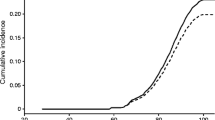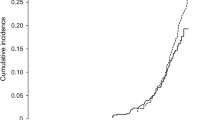Abstract
Aims/hypothesis
The aim of this work was to evaluate whether the association of prediabetes with dementia is explained by the intervening onset of diabetes.
Methods
Among participants of the Atherosclerosis Risk in Communities (ARIC) study we defined baseline prediabetes as HbA1c 39–46 mmol/mol (5.7–6.4%) and subsequent incident diabetes as a self-reported physician diagnosis or use of diabetes medication. Incident dementia was ascertained via active surveillance and adjudicated. We quantified the association of prediabetes with dementia risk before and after accounting for the subsequent development of diabetes among ARIC participants without diabetes at baseline (1990–1992; participants aged 46–70 years). We also evaluated whether age at diabetes diagnosis modified the risk of dementia.
Results
Among 11,656 participants without diabetes at baseline, 2330 (20.0%) had prediabetes. Before accounting for incident diabetes, prediabetes was significantly associated with the risk of dementia (HR 1.12 [95% CI 1.01, 1.24]). After accounting for incident diabetes, the association was attenuated and non-significant (HR 1.05 [95% CI 0.94, 1.16]). Earlier age of onset of diabetes had the strongest association with dementia: HR 2.92 (95% CI 2.06, 4.14) for onset before 60 years; HR 1.73 (95% CI 1.47, 2.04) for onset at 60–69 years; and HR 1.23 (95% CI 1.08, 1.40) for onset at 70–79 years.
Conclusions/interpretation
Prediabetes is associated with dementia risk but this risk is explained by the subsequent development of diabetes. Earlier age of onset of diabetes substantially increases dementia risk. Preventing or delaying progression of prediabetes to diabetes will reduce dementia burden.
Graphical Abstract



Similar content being viewed by others
Abbreviations
- ARIC:
-
Atherosclerosis Risk in Communities
- FG:
-
Fasting glucose
References
Zhang J, Chen C, Hua S et al (2017) An updated meta-analysis of cohort studies: diabetes and risk of Alzheimer’s disease. Diabetes Res Clin Pract 124:41–47. https://doi.org/10.1016/j.diabres.2016.10.024
Cheng G, Huang C, Deng H, Wang H (2012) Diabetes as a risk factor for dementia and mild cognitive impairment: a meta-analysis of longitudinal studies. Intern Med J 42(5):484–491. https://doi.org/10.1111/j.1445-5994.2012.02758.x
Chatterjee S, Peters SAE, Woodward M et al (2016) Type 2 diabetes as a risk factor for dementia in women compared with men: a pooled analysis of 2.3 million people comprising more than 100,000 cases of dementia. Diabetes Care 39(2):300–307. https://doi.org/10.2337/dc15-1588
Echouffo-Tcheugui JB, Selvin E (2021) Prediabetes and what it means: the epidemiological evidence. Annu Rev Public Health 42:59–77. https://doi.org/10.1146/annurev-publhealth-090419-102644
Rawlings AM, Sharrett AR, Schneider ALC et al (2014) Diabetes in midlife and cognitive change over 20 years: a cohort study. Ann Intern Med 161(11):785–793. https://doi.org/10.7326/M14-0737
Garfield V, Farmaki A-E, Fatemifar G et al (2021) The relationship between glycaemia, cognitive function, structural brain outcomes and dementia: a Mendelian randomisation study in the UK biobank. Diabetes 70(10):2313–2321. https://doi.org/10.2337/db20-0895
Kim MK, Han K, Koh ES et al (2021) Cumulative exposure to impaired fasting glucose and future risk of type 2 diabetes mellitus. Diabetes Res Clin Pract 175:108799. https://doi.org/10.1016/j.diabres.2021.108799
Tabák AG, Herder C, Rathmann W, Brunner EJ, Kivimäki M (2012) Prediabetes: a high-risk state for diabetes development. Lancet 379(9833):2279–2290. https://doi.org/10.1016/S0140-6736(12)60283-9
Hostalek U (2019) Global epidemiology of prediabetes - present and future perspectives. Clin Diabetes Endocrinol 5(1):5. https://doi.org/10.1186/s40842-019-0080-0
Fang M, Echouffo-Tcheugui JB, Selvin E (2020) Burden of complications in U.S. adults with young-onset type 2 or type 1 diabetes. Diabetes Care 43(4):e47–e49. https://doi.org/10.2337/dc19-2394
Ang GY (2020) Age of onset of diabetes and all-cause mortality. World J Diabetes 11(4):95–99. https://doi.org/10.4239/wjd.v11.i4.95
BarbielliniAmidei C, Fayosse A, Dumurgier J et al (2021) Association between age at diabetes onset and subsequent risk of dementia. JAMA 325(16):1640–1649. https://doi.org/10.1001/jama.2021.4001
Echouffo-Tcheugui JB, Narayan KM, Weisman D, Golden SH, Jaar BG (2016) Association between prediabetes and risk of chronic kidney disease: a systematic review and meta-analysis. Diabetic Med 33(12):1615–1624. https://doi.org/10.1111/dme.13113
American Diabetes Association (2022) Standards of medical care in diabetes—2022 abridged for primary care providers. Clin Diabetes 40(1):10–38. https://doi.org/10.2337/cd22-as01
Schneider ALC, Pankow JS, Heiss G, Selvin E (2012) Validity and reliability of self-reported diabetes in the atherosclerosis risk in communities study. Am J Epidemiol 176(8):738–743. https://doi.org/10.1093/aje/kws156
Knopman DS, Gottesman RF, Sharrett AR et al (2016) Mild cognitive impairment and dementia prevalence: the atherosclerosis risk in communities neurocognitive study. Alzheimers Dement (Amst) 2:1–11. https://doi.org/10.1016/j.dadm.2015.12.002
Schneider ALC, Sharrett AR, Gottesman RF et al (2015) Normative data for 8 neuropsychological tests in older blacks and whites from the atherosclerosis risk in communities (ARIC) study. Alzheimer Dis Assoc Disord 29(1):32–44. https://doi.org/10.1097/WAD.0000000000000042
Morris JC (1993) The Clinical Dementia Rating (CDR): current version and scoring rules. Neurology 43(11):2412–2414. https://doi.org/10.1212/wnl.43.11.2412-a
Folstein MF, Folstein SE, McHugh PR (1975) “Mini-mental state”: a practical method for grading the cognitive state of patients for the clinician. J Psychiatr Res 12(3):189–198. https://doi.org/10.1016/0022-3956(75)90026-6
American Heart Association Recommendations for Physical Activity in Adults and Kids. Available from www.heart.org. https://www.heart.org/en/healthy-living/fitness/fitness-basics/aha-recs-for-physical-activity-in-adults. Accessed 3 Aug 2022
Centers for Disease Control and Prevention (2022) National Diabetes Statistics Report. Available from www.cdc.gov/diabetes/data/statistics-report/index.html. Accessed 23 Aug 2022
Centers for Disease Control and Prevention (2021) Prediabetes - Your Chance to Prevent Type 2 Diabetes. Available from http://bit.ly/2hMpYrt. Accessed 23 Aug 2022
Alva ML, Chakkalakal RJ, Moin T, Galaviz KI (2022) The diabetes prevention gap and opportunities to increase participation in effective interventions. Health Affairs 41(7):971–979. https://doi.org/10.1377/hlthaff.2022.00259
Xu W, Qiu C, Gatz M, Pedersen NL, Johansson B, Fratiglioni L (2009) Mid- and late-life diabetes in relation to the risk of dementia: a population-based twin study. Diabetes 58(1):71–77. https://doi.org/10.2337/db08-0586
Kellar D, Craft S (2020) Brain insulin resistance in Alzheimer’s disease and related disorders: mechanisms and therapeutic approaches. Lancet Neurol 19(9):758–766. https://doi.org/10.1016/S1474-4422(20)30231-3
Korte N, Nortley R, Attwell D (2020) Cerebral blood flow decrease as an early pathological mechanism in Alzheimer’s disease. Acta Neuropathol 140(6):793–810. https://doi.org/10.1007/s00401-020-02215-w
Li X, Song D, Leng SX (2015) Link between type 2 diabetes and Alzheimer’s disease: from epidemiology to mechanism and treatment. CIA 10:549–560. https://doi.org/10.2147/CIA.S74042
Arnold SE, Arvanitakis Z, Macauley-Rambach SL et al (2018) Brain insulin resistance in type 2 diabetes and Alzheimer disease: concepts and conundrums. Nat Rev Neurol 14(3):168–181. https://doi.org/10.1038/nrneurol.2017.185
Launer LJ (2020) Interrelationships among central insulin signalling, diabetes, and cognitive impairment. Lancet Neurol 19(8):640–642. https://doi.org/10.1016/S1474-4422(20)30172-1
Rensma SP, van Sloten TT, Houben AJHM et al (2020) Microvascular dysfunction is associated with worse cognitive performance. Hypertension 75(1):237–245. https://doi.org/10.1161/HYPERTENSIONAHA.119.13023
Ceriello A, Esposito K, Piconi L et al (2008) Oscillating glucose is more deleterious to endothelial function and oxidative stress than mean glucose in normal and type 2 diabetic patients. Diabetes 57(5):1349–1354. https://doi.org/10.2337/db08-0063
Fischer R, Maier O (2015) Interrelation of oxidative stress and inflammation in neurodegenerative disease: role of TNF. Oxid Med Cell Longev 2015:e610813. https://doi.org/10.1155/2015/610813
Monnier L, Mas E, Ginet C et al (2006) Activation of oxidative stress by acute glucose fluctuations compared with sustained chronic hyperglycemia in patients with type 2 diabetes. JAMA 295(14):1681–1687. https://doi.org/10.1001/jama.295.14.1681
Author information
Authors and Affiliations
Corresponding author
Ethics declarations
Acknowledgements
The authors thank the staff and participants of the ARIC study for their important contributions.
Data availability
The ARIC data are not publicly available due to confidentiality issues. Investigators can access data from the ARIC study by submitting a manuscript proposal to aricpub@unc.edu.
Funding
The ARIC study has been funded in whole or in part with Federal funds from the National Heart, Lung, and Blood Institute, National Institutes of Health, Department of Health and Human Services, under contract numbers HHSN268201700001I, HHSN268201700002I, HHSN268201700003I, HHSN268201700005I and HHSN268201700004I. Collection of neurocognitive data was funded by U01 2U01HL096812, 2U01HL096814, 2U01HL096899, 2U01HL096902 and 2U01HL096917 from the NIH (NHLBI, National Institute of Neurological Disorders and Stroke [NINDS], National Institute on Aging [NIA] and National Institute on Deafness and Other Communications Disorders [NIDCD]); previous brain MRI examinations were funded by R01-HL70825 and biomarkers by R01-HL134320 from the NHLBI. PLL was supported NIH/NHLBI grant K24 HL159246. RFG was supported by the National Institute of Neurological Disorders and Stroke Intramural Research Program. ES was supported by NIH/NHLBI grants K24 HL152440 and R01 HL158022, NIH/NIDDK grants R01 DK089174 and R01 DK128837, and NIH/NIA grant RF1 AG074044.
Authors’ relationships and activities
ES is on the advisory board for Diabetologia and had no role in peer-review of the manuscript. All other authors declare that there are no relationships or activities that might bias, or be perceived to bias, their work.
Contribution statement
JH, MF, JC and ES designed the study, researched the data and contributed to discussion. JH conducted the analyses and wrote the initial manuscript. All authors provided substantial contributions to the interpretation of data, made critical revisions to the manuscript and approved the final manuscript. JH is the guarantor of this work and, as such, had full access to all the data in the study, controlled the decision to publish and takes responsibility for the integrity of the data and the accuracy of the data analysis. The corresponding author, ES, attests that all listed authors meet authorship criteria and that no others meeting the criteria have been omitted.
Additional information
Publisher's note
Springer Nature remains neutral with regard to jurisdictional claims in published maps and institutional affiliations.
Supplementary Information
Below is the link to the electronic supplementary material.
Rights and permissions
Springer Nature or its licensor (e.g. a society or other partner) holds exclusive rights to this article under a publishing agreement with the author(s) or other rightsholder(s); author self-archiving of the accepted manuscript version of this article is solely governed by the terms of such publishing agreement and applicable law.
About this article
Cite this article
Hu, J., Fang, M., Pike, J.R. et al. Prediabetes, intervening diabetes and subsequent risk of dementia: the Atherosclerosis Risk in Communities (ARIC) study. Diabetologia 66, 1442–1449 (2023). https://doi.org/10.1007/s00125-023-05930-7
Received:
Accepted:
Published:
Issue Date:
DOI: https://doi.org/10.1007/s00125-023-05930-7




